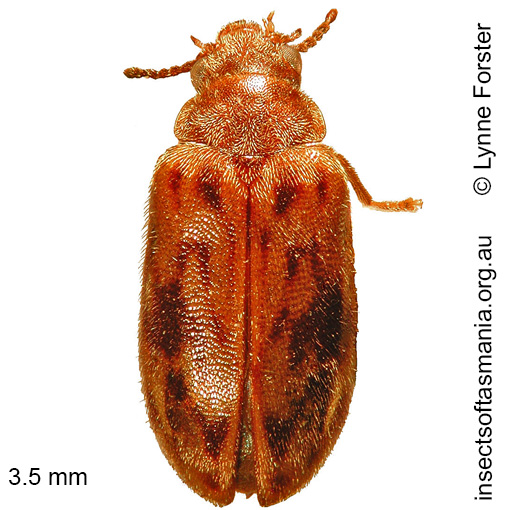
Spilotocyphon spilotus (Blackburn, 1892) (a species of marsh-beetle)
Basis for Tasmanian occurrence
Semmens, T.D., McQuillan, P.B. & Hayhurst, G. (1992). Catalogue of the Insects of Tasmania. Government of Tasmania: Department of Primary Industry, 104 pp. (as Cyphon spilotus)
TMAG collections
Classification
Order: Coleoptera
Suborder: Polyphaga
Superfamily: Scirtoidea
Family: Scirtidae
Morphology
Typical length (mm): 3.5
Flightedness: winged and assumed capable of flight
Source literature on morphology and taxonomy (*primary taxonomic source, where identified):
Watts, C.H.S. (2007). Revision of Australian Pseudomicrocara Armstrong (Coleoptera: Scirtidae). Trans. Roy. Soc. S. Aust. 131 (1): 1-82.
Watts, C.H.S, Bradford, T.M., Cooper, S.J.B & Libonatti, T.M. (2020). New genera, species and combinations in the Pseudomicrocara Armstrong group (Coleoptera: Scirtidae) based on morphology supported by mitochondrial and nuclear gene sequence data. Zootaxa 4831: 1 -66.
Ecology
Assumed larval feeding: detritivore
Association with dead wood or old trees: not saproxylic
Ecological attributes: — Affliliated with young (ex-clearfelled) forest (Baker, 2006a) — Associated with mudguts (Yee et al., 2006) — May occupy logs or trunks of Eucalyptus obliqua, at least temporarily, since found having emerged within a year of felling (Grove & Bashford, 2003) — May occupy logs or trunks of Eucalyptus obliqua, at least temporarily, since found having emerged within six years of felling (Grove et al., 2009).
Collection method(s) for TFIC material: — At light (with use of light-trap) — Baited trapping (funnel trap) — Emergence trapping from log of Eucalyptus obliqua — Flight intercept trapping (trough below Malaise trap) — Hand collection from flowers of Eucryphia lucida (Ettershanks & Ettershanks, 1993) — Knockdown fogging of canopy of Nothofagus cunninghamii — Knockdown spraying of bark of Eucalyptus obliqua — Log-mounted flight intercept trapping — Malaise trapping — Pitfall trapping — Sticky trapping on Eucalyptus obliqua — Trunk window trapping (Harrison, 2007) — Vane trapping.
Source ecological literature:
Grove, S.J. & Bashford, R. (2003). Beetle assemblages from the Warra log decay project: insights from the first year of sampling. Tasforests 14: 117-129.
Grove, S.J. (2009b). Beetles and fuelwood harvesting: a retrospective study from Tasmania’s southern forests. Tasforests 18: 77-99.
Hopkins, A.J.M. et al. (2005). Wood decay fungi and beetle assemblages associated with living Eucalyptus obliqua trees: early results from studies at the Warra LTER Site, Ta
Baker, S.C. (2006b). Ecology and conservation of ground-dwelling beetles in managed wet eucalypt forest: edge and riparian effects. PhD thesis, Univ. of Tasmania, Hobart.
Grove, S. et al. (2009). A long-term experimental study of saproxylic beetle … succession in Tasmanian Eucalyptus … logs… In: Fattorini, S. (Ed.), Insect Ecology and Conservation. Research Signpost, pp. 71-114.
Harrison, K.S. (2007). Saproxylic beetles associated with habitat features in Eucalyptus obliqua trees in the southern forests of Tasmania. PhD thesis, Dept. of Zoology, Univ. of Tasmania, Hobart.
Yee, M. (2005). The ecology and habitat requirements of saproxylic beetles native to Tasmanian wet eucalypt forests: potential impacts of commercial forestry practices. PhD thesis, Univ. of Tasmania, Hobart.
Yee, M. et al. (2006). Brown rot in inner heartwood: why large logs support characteristic … beetle assemblages … In Grove, S.J. & Hanula, J.L. (eds.) Insect biodiv. and dead wood, pages 42-56. USDA For. Serv., SRS.

